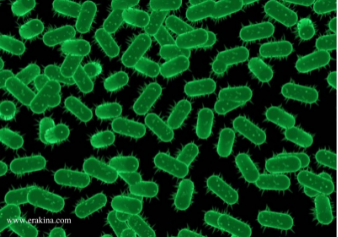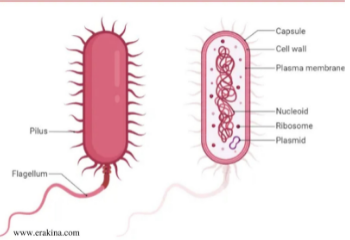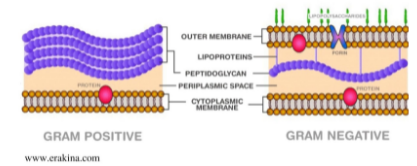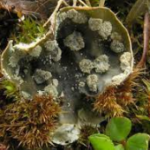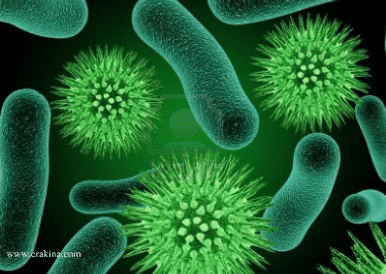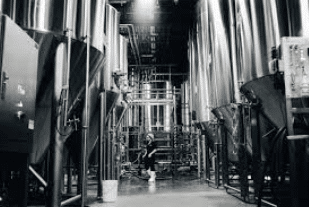Bacteria is a single-celled microorganism found abundantly in the environment and capable of living in extreme conditions and inside the human body.
Bacteria are considered prokaryotic organisms as they contain only a single cell. However, the prokaryotic organism can be divided into bacteria and Archaea. The difference between bacteria and archaea is that bacteria’s cell wall comprises peptidoglycan composed of proteins and sugars. In contrast, the cell wall of archaea is composed of polysaccharides containing sugar complexes. Archaea are known to survive in extreme environments such as hot springs, freezing temperatures, high and low pH, etc., that are uninhabitable to most living organisms. Therefore, archaea are also called extremophiles. The bacteria have been estimated to have been in existence since 3.5 billion years ago, while archaeans have existed even before the bacteria. Around four billion years ago, the archaeans and bacteria developed separately from the same ancestor. Hence genetically and biochemically, the archaeans are different from the bacteria.
An Overview of Bacterial Cell
Currently, bacterial species that have been identified are about 30,000, and more are being discovered. The bacterial species consists of two kinds: harmless bacteria and harmful bacteria. Bacteria belonging to mainly Lactobacillus species are considered good bacteria since they have probiotic characteristics. These probiotic bacteria (good bacteria) are found in the different parts of the human and animal bodies. These good bacteria protect the body against harmful bacteria that cause diseases. The environment is filled with bacteria that are quite harmless to other living organisms. However, when they contact a host that provides optimal conditions for their growth, they can become virulent.
The bacteria are prokaryotes consisting of undefined nuclei, membrane-bound organelles, and circular DNA called a plasmid. The bacteria come in different shapes, such as bacilli (rod), vibrios (comma), cocci (spherical), spirilla (spiral), and spirochaetes (corkscrew). Antoni van Leeuwenhoek was the first person to study bacteria under a microscope in the later 1600s. By the 19th century, French scientist Louis Pasteur and German physicist Robert Koch explained the functions of pathogenic bacteria. Later, numerous scientists have made contributions to identifying different bacterial species and describing their crucial roles in the Earth’s ecosystem. The determination of various bacteria helped revolutionize the field of medicine.
Components and their Functions
- Capsule
The capsule is the outer layer of a bacterial cell made of complex carbohydrates called polysaccharides. The capsule protects the bacterium from being engulfed (phagocytosis) by large microorganisms. One of the significant roles of the capsule is to prevent the bacterium from drying out. In disease-causing bacteria, the virulence factor is caused by the capsule, while bacteria that do not cause diseases are avirulent as they are non-capsulated.
- Cell wall
The cell wall is responsible for shaping the bacterium and protecting the cytoplasmic membrane from the environment. It is made up of a polysaccharide (protein-sugar) compound; called peptidoglycan. The cell wall anchors pili and flagella, originating from the cytoplasmic membrane protruding to the outside through the cell wall. When there is a significant difference in the osmotic pressure between the cytoplasm and the environment, the strength of the cell wall protects the cell from exploding. Based on the bacterial cell wall composition, Hans Christian Gram in 1884 divided them into two categories; gram-positive and gram-negative, based on their ability to retain the stain dye.
- Cytoplasm
Most of the functions are carried out in the cytoplasm (protoplasm) of the bacterial cells, such as metabolism, replication, and cell growth. The plasmids are circular DNA that is uninvolved in reproduction. These plasmids are not crucial for survival, as they replicate independently. Instead, it contains genetic information for commencing cell division by binary fission.
- Cytoplasmic membrane
The membrane covering the cytoplasm (interior of the bacterium) is composed of proteins and phospholipids that aid in transporting materials in and out of the cell. The primary function is to interact with the environment selectively, as they can adapt to different environments.
- Nucleoid
This is the area in the cytoplasm that contains DNA that is not in the membrane-bound nucleus. They are responsible for the process of replication.
- Ribosomes
Bacterial ribosomes have different compositions when compared to eukaryotic ribosomes. Ribosomes are the “factories” in cells that translate genetic code from the nucleic acid into amino acids, which form into proteins that perform all functions in the cell. The ribosomes are free-floating structures in the cytoplasm compared to the eukaryotes, where the ribosomes are attached to the endoplasmic reticulum.
- Flagella
Flagella is a hair-like extension that helps the bacterium with their locomotion. The motion of the bacterium takes place as the flagella beat in a propeller-like motion to push the bacterium to move forward.
- Pili
These are tiny hair-like projections found outside the cell surface that aids the bacterium in adhering itself to surfaces or other cells. Disease-causing bacteria require pili to help them attach to the host tissue. Otherwise, they cannot express their virulence factors. Bacteria can also exchange fragments of their plasmid DNA with each other through specialized pili.
Distinguish between Gram-positive and Gram-negative bacteria
The bacteria are differentiated based on their ability to retain the dye. When the bacteria are exposed to gram stain, the bacteria capable of retaining the purple color of the stain are gram-positive as their cell wall can trap the dye. In contrast, gram-negative bacteria cannot hold the dye, as they have a thin cell wall that releases the dye easily when rinsed with acetone or alcohol.
- Archaea and bacteria reproduce asexually. Archaea reproduce by fragmentation, binary fission, and budding process, whereas eubacteria are spore-forming bacteria that stay dormant for years.
- The cell membrane composition of archaea is by pseudopeptidoglycan, while the cell membrane in bacteria is composed of peptidoglycan.
- The metabolic activity in archaea is by methanogenesis (the process of generating methane). In contrast, bacteria have various metabolic activities such as aerobic and anaerobic respiration, photosynthesis, autotrophy, and fermentation.
- When archaea consist of three RNAs, the bacteria consist of only a single RNA.
- Archaea can sustain extreme and harsh conditions like volcanic vents, hypersaline environments, low and high pH, etc. In comparison, bacteria are usually found in bodies of plants and animals, soil, water, etc.

